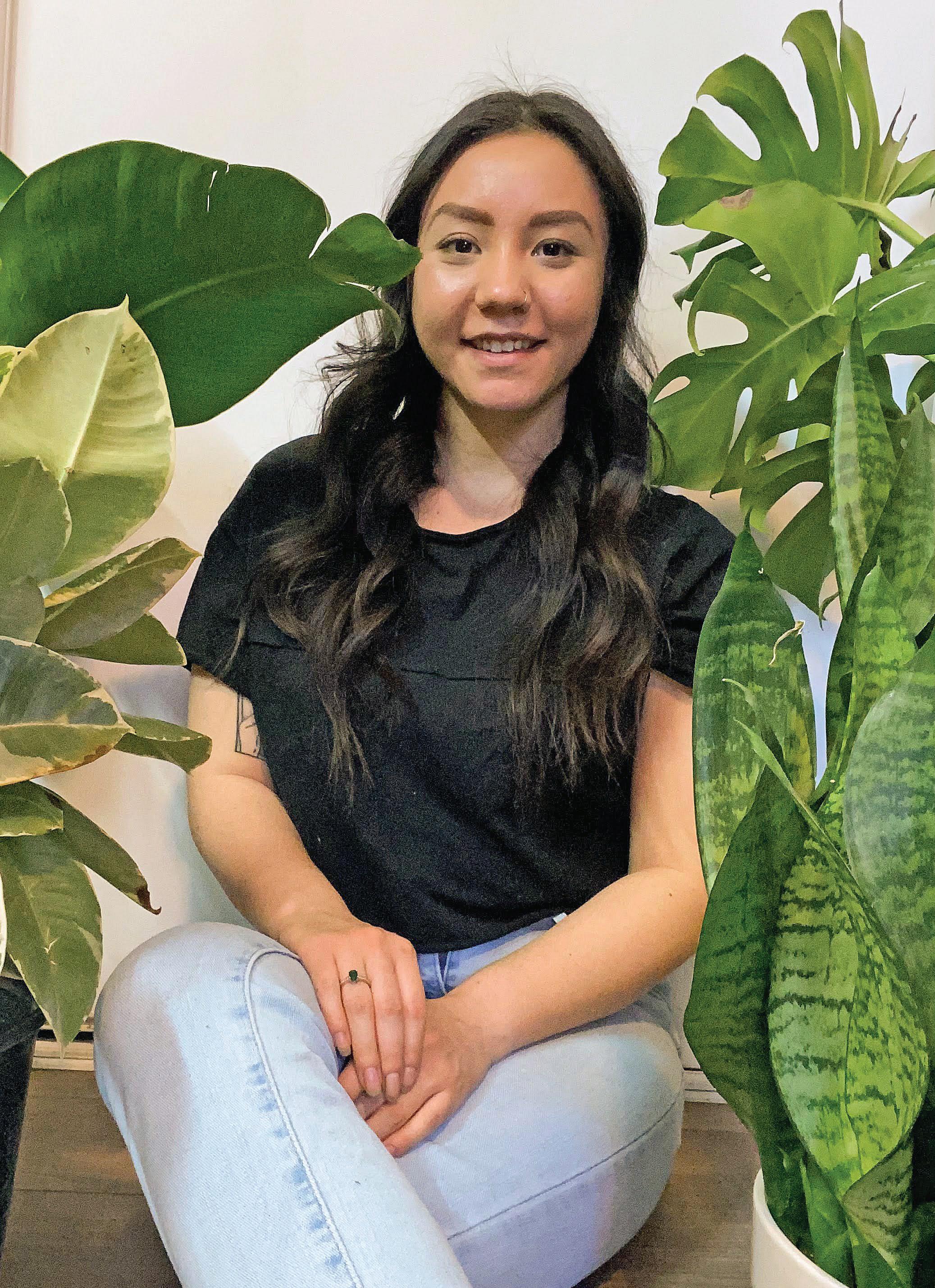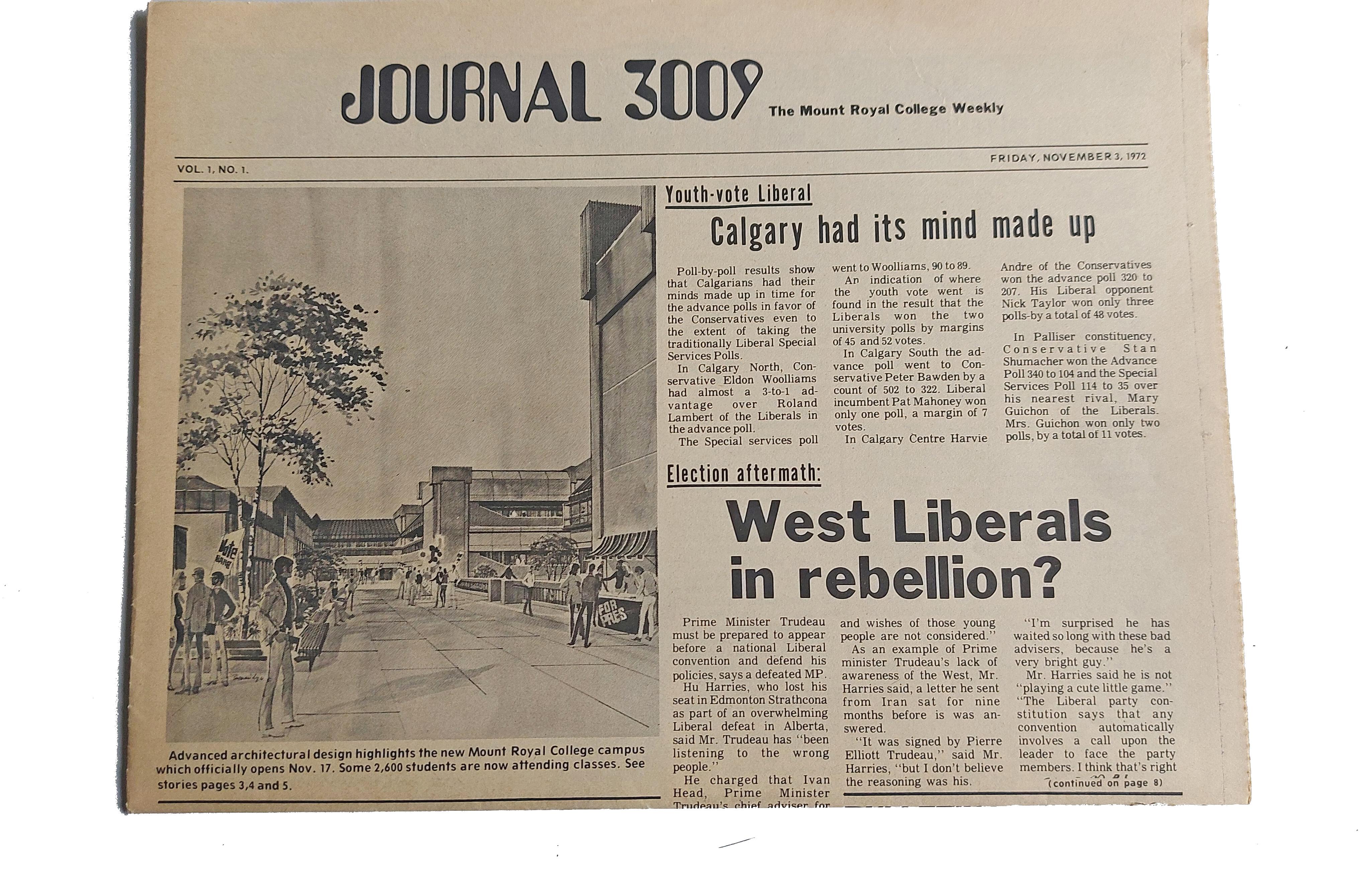
11 minute read
The Calgary Journal looks back on
MEDIA A GREAT PRINT RUN
Advertisement
The Calgary Journal began publishing 49 years ago, chronicling stories big and small about campus life and events across the city. While that endeavour continues online, this is the final edition of the print Journal published by Mount Royal University’s journalism program. In 2022, it will be replaced with a national human rights magazine called Justice. Looking back, here’s how the Journal started and became what it is today.
The very first edition of the Calgay Journal, published Friday November 3, 1972 just after the Lincoln Park Campus opened.
PHOTO: CHRISTIAN KINDRACHUK
CHRISTIAN KINDRACHUK ckindrachuk@cjournal.ca

Editorial meeting between John Balcers (on the left) and students circa 1990. PHOTO: PAUL COATES
The Calgary Journal began in the fall of 1972, the same time Mount Royal College opened its Lincoln Park Campus doors . Back then it was the Journal 3009, named after the number on the newsroom door located up on the third floor of MRC’s modern campus. John Balcers, at the helm of the program, was responsible for bringing the Journal and its pragmatic philosophy into existence.
“We decided we’d teach journalism differently, from simply making it an academic thing, I wanted to make it a real thing,” said Balcers, who was at the Calgary Herald when he started teaching at Mount Royal in 1965.
Part of making that real journalism experience was having the Journal 3009 publish content on a weekly basis for the campus community.
“We were just experimenting – will this work? And so we wanted to make sure that as much as possible [it was] a real-life experience but, at the same time, make sure that we covered all the fundamentals of journalism.”
While a weekly publication schedule offered experience to students, it also meant more work for everyone involved, including the instructors. Ron MacDonald was hired to help in 1984 after being the news director for CKUA radio for Calgary and Edmonton.
“The idea of having the newspaper at the center of all of that, was that there was concrete practice to discuss. So it wasn’t a discussion of theory, it was a discussion of concrete practice theorized,” MacDonald explained.
Putting in extra work was necessary for students to meet publication deadlines, something they weren’t always happy with.
“The students oftentimes would hate me,” recalls Balcers. “We would have 7:00 and 8:00 a.m. meetings for putting out the paper, outside of classes. And anybody who was on that editorial board would have to be there.
“We were making them [students] jobready in just a two-year timespan. So that meant they really had to hone their skills as far as reporting, as far as writing, editing, then also doing layout,” said Paul Coates, who has been Mount Royal’s part-time photography instructor since 1987, in addition to working for several publications across the province.
During the first few years, it was just Balcers and MacDonald, acting as editors, along with Coates teaching the journalism program.
“Answering questions and doing critiques of stories and encouraging people, and once in a while making people cry, was a central aspect of the whole program. I think it’s safe to say that the program revolved around the production of the Journal,” said MacDonald, now retired.
Jose Rodriguez, a graduate from 1993, felt it as a busy time and underestimated the demand and effort needed.
“I always remember the first story I ever submitted to Ron McDonald. He used to have this grading method, which was for every mistake you made, you get 10 points taken off. So you start with 100 points, you know, 100 per cent if you have the perfect story.
“And the very first one I did for him, I got it back, and my score on it was minus 270. Which means I would have made 37 mistakes in there, and so you know it wasn’t a soft ride.”
Despite the rigour, Rodriguez says they were good instructors, even when MacDonald placed him at the Calgary Sun for a practicum he didn’t want.
“I told Ron, ‘Hey, can you just put me anywhere except for the Sun, and he put me in the Sun. Which, as soon as I got there, the city editor figured, ‘You know what, this kid’s working his butt off, let’s bring him in for $25 a story to cover our weekend coverage, etc.’
“And so they brought me in on weekends past my practicum and then that summer. They just kept calling me and then by October of the year that I graduated, they basically offered me a full-time job.”
Rodriguez later became the editorin-chief of the Calgary Sun and Calgary Herald. While it may not have been easy, the learning experience he got from the Journal over the years helped him. Those experiences weren’t only for students, teachers too had their own epiphanies.
“The biggest learning moment for myself probably came one day when I tore up somebody’s story, “ said MacDonald. “And she came back to me the next day with a piece of writing that was really beautiful, and said, ‘You know, the way you do the criticism of what I’m up to isn’t helpful because I’m already able to do this, which I think is pretty good.’
“So I read it, and I said, ‘It’s better than pretty good, and I really need to think about how I’m doing this.’ The result was that I was a lot less assertive, and a lot less confident about my critiques and much more interested in dialogue and discussion. And I was much happier thereafter, and so were the people I was working with.”
CALGARYJOURNAL.CA MAY/JUNE 2021 33
MacDonald said his teaching evolved over his 32 years at Mount Royal. It started with a “strict newsroom-type learnfrom-your-mistakes grumpy-editor-to-beginner-reporter,” to a more considerate approach involving one-to-one tutoring.
The Journal itself also went through a series of changes over the ‘80s and ‘90s that included dropping 3009 from the Journal’s name, then starting to run on a bi-weekly publication schedule. Around that time the program expanded from being a two-year degree to a three-year applied degree program.
Balcers, who launched the Journal and held his post for 35 years at Mount Royal, retired in 2000. Shauna SnowCapparelli, formerly with the Los Angeles Times, came in to take his place in 2001. To form a new teaching team, she joined Robert Bragg, who came from the Hearld, and Terry Field, a broadcast producer that had been with the CBC.
“I think it’s fair to say that the Journal morphed as well over that period,” said Field, noting that Bragg brought up the idea of expanding it to a city paper.
“And in the context of that we altered the distribution, started printing more copies, bought some newspaper boxes to put on street corners and racks to put in restaurants and coffee shops. We started distributing about 8,000 to 10,000 copies a month, or per-print issue.”
Having that broader focus and readership allowed students to report on stories from different communities around the city.
Covering a variety of different stories expanded over the years, but production never really changed for students. According to Field, having students work together helped foster a collegial group environment and allowed them to coordinate all the moving parts that come with putting a paper together.
“Just being there all day or over a couple of days, putting in the time and watching everybody work hard, and play and laugh, and so on. That was always good. My favourite part was afterwards when everybody would go for a beer.”
That sense of community and collaboration of putting a paper together was something that also stuck with Emma Gilchrist, a former student who graduated in 2006.
“I remember some late nights and the camaraderie, people getting takeout for dinner and just working away, getting to see the invisible work that goes into making a publication happen, which I think is really important. A lot of times, people don’t see the work that goes on, like underneath the hood to make a publication possible.”
Having students put in that effort, take the initiative and grow was always something that Snow-Capparelli enjoyed.
“Seeing them from where they started, or even in second year, to where they end when they graduate and watching that path, it’s just really cool.”
Gilchrist, who went on to be the co-founder of an awardwinning not-for-profit environmental news service called The Narwhal, remembers being assigned stories from sports to city hall meetings, and to finding a story by approaching people on the street – doing a “streeter.”
“We had to do every type of story, and I’ve always remembered that. I just thought, in hindsight, it was such a rigorous way of just throwing you in the deep end. I think that was a really cool thing about Mount Royal and about the Journal, is that it really threw you in the deep end. And there’s no better way to learn than doing.”
Janice Paskey, a professor since 2008, remembers how producing a print edition was something students really wanted to do, even as the Calgary Journal website was starting up. Student writing on the Macintosh classic computer to for an assignment. PHOTO: PAUL COATES


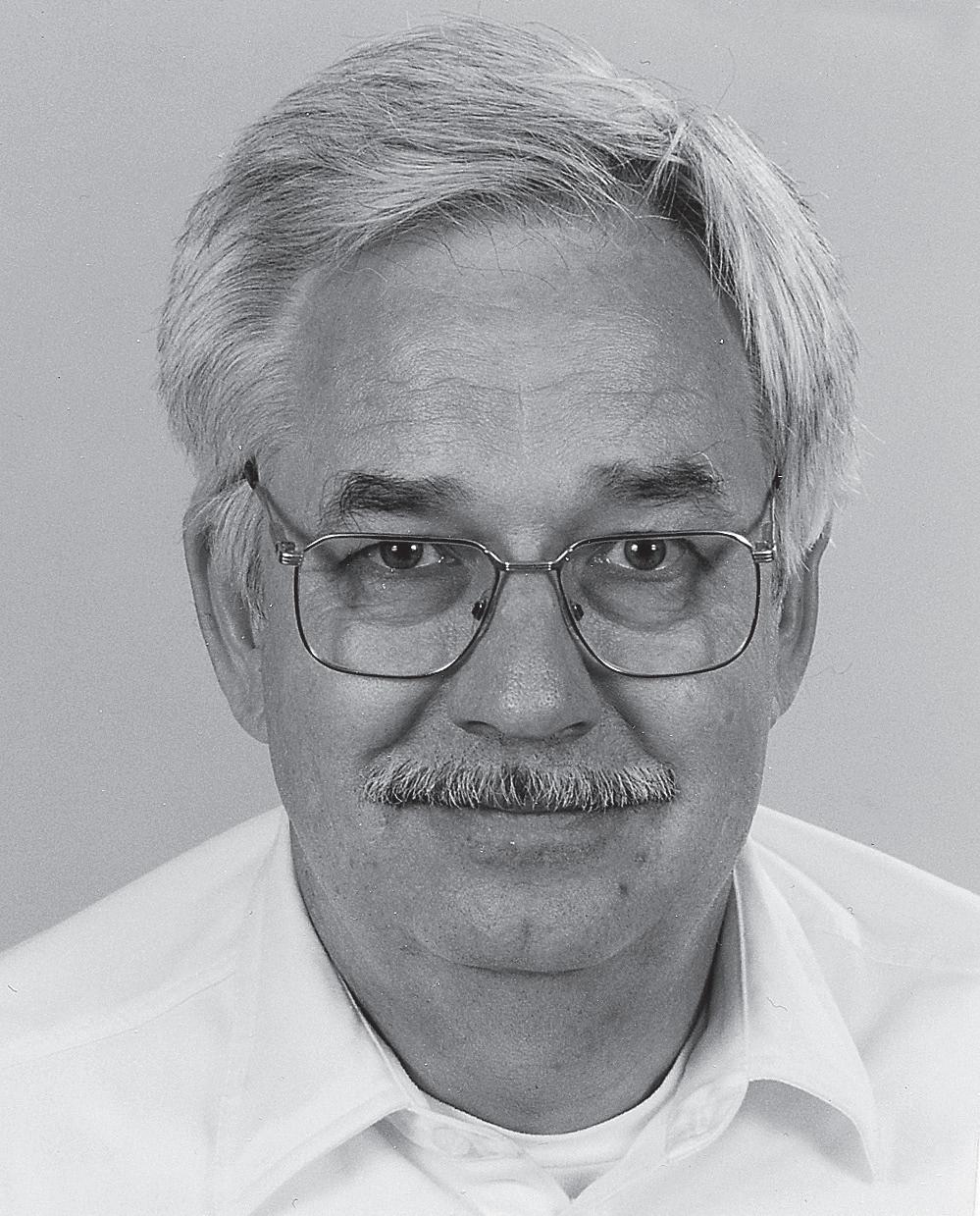

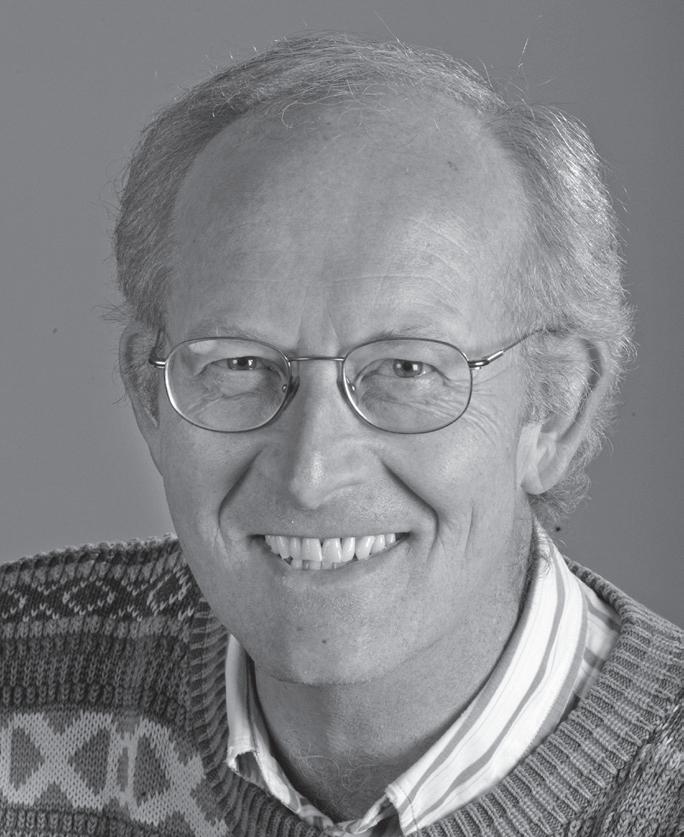

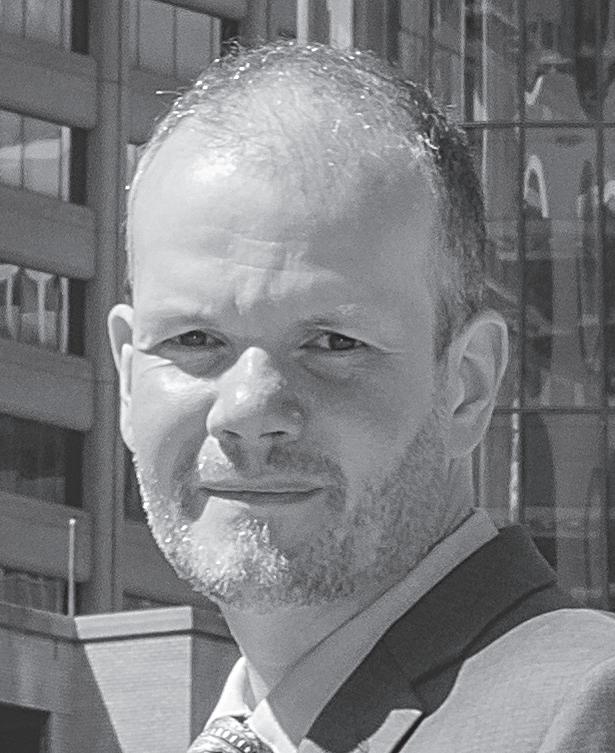

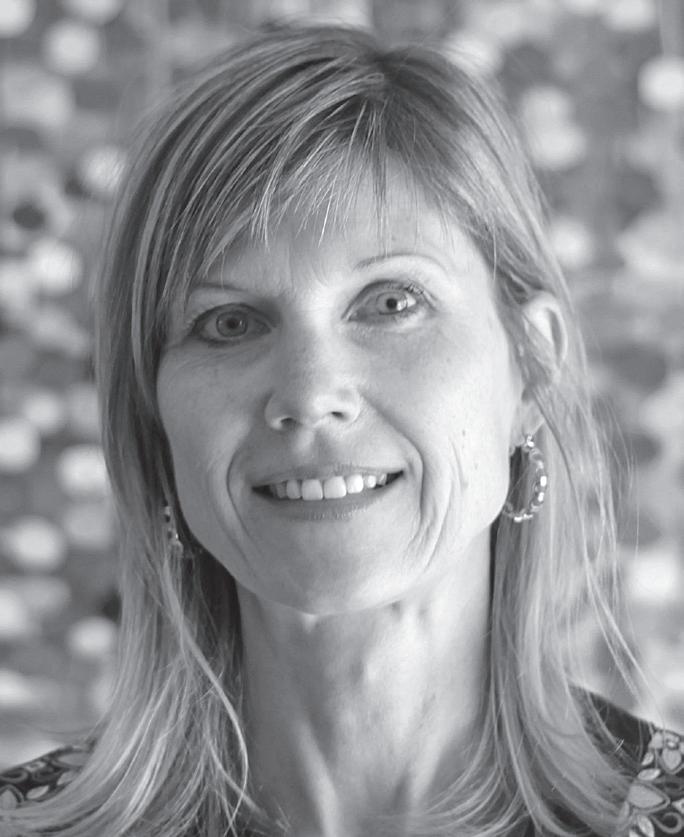
Going clockwise from the top left, past supervising faculty editors for the Calgary Journal: John Balcers, Ron MacDonald, Robert Bragg, Terry Field, Janice Paskey,
Archie McLean, Sean Holman and Shauna Snow-Capparelli. PHOTOS: TOP ROW PHOTOS COURTESY OF PAUL COATES. BOTTOM ROW PHOTOS PROVIDED BY SOURCES RESPECTIVELY.
“I would say the print journal was still kind of considered the premier product. And if students didn’t get their stories in the print product, they felt very disappointed. ”
Paskey recalls that the content was good and allowed students to tell a range of stories that were meaningful, quirky and no one else was covering. The content still speaks for itself. The Journal has won awards from the Alberta Weekly Newspaper Association, the Associated Collegiate Press and Emerge Media, to name a few.
In 2004, it became the Calgary Journal reflecting its city-wide coverage. When Mount Royal became a university in 2009, the journalism program became a four-year degree and the Calgary Journal changed its publication schedule to a monthly and then a bi-monthly newsmagazine distributed across the city.
In the last 50 years, hundreds of students have worked on the Journal and in the process acquired reporting skills that, according to Paul Coates, are applicable anywhere they went after graduating.
“It used to be that Kathy [Coates’ wife] and I would travel somewhere, and I’d pick up the paper and there’d be somebody that I recognize. And it was from when I worked on newspapers or former students, and that’s pretty cool. She’d always say, ‘Yes, I know, you got to find a paper.’”
While the tactile days of putting a paper together might be different, it doesn’t mean that journalism isn’t any less important, notes MacDonald.
>Emma Gilchrist
“I think that the motivation to be a journalist is a noble one. It’s an impulse to be of service in a really important way, and that kind of thing is great. And I expect it to continue, and I expect people to continue to be creative and clever and find ways to continue to do journalism in spite of all of the things that stand in the way of getting it done and getting it done well, and doing really good journalism.”
This, the final story of the print issue, doesn’t mark the end of journalism at Mount Royal University. The Calgary Journal will still have its online presence, and in the fall of 2021 the print edition will evolve into a new nationwide human rights magazine called Justice.
Sally Haney, chair of MRU’s journalism program, states: “Justice is a powerful vehicle for change. Using evidence-based reporting, our student journalists will have a platform in which to expose social, political and environmental inequities, while also searching and reporting on solutions. Our intent is to encourage stories that help audiences better understand how systems undermine the rights of equity-deserving groups.”
Sean Holman, the faculty editor for the new publication, adds that, “Fundamental rights are under threat around the world – from the right to a healthy environment to the right not be discriminated against. And we believe Justice will help safeguard them.”
Justice will have a bi-annual publication schedule and still be a student-run publication. The first issue will be published in January 2022.









